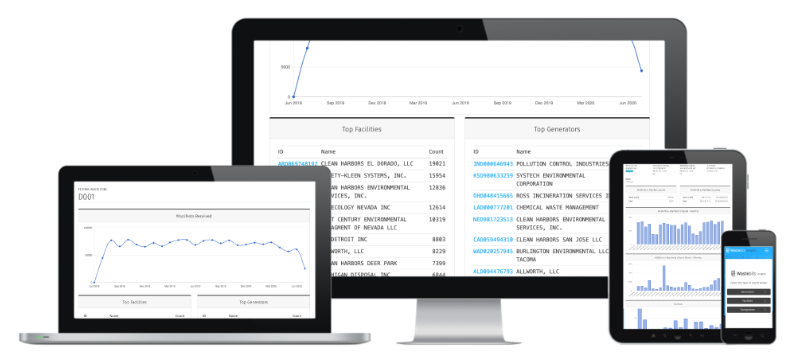Information Waste Services
NAICS Code 51
Discover Information waste handlers (NAICS Code 51) as reported to the United States EPA. Whether they are generators, transporters, transfer facilities, recyclers or TSDF locations, click on each listing below for details and contact information.

Looking for detailed information regarding waste trends and data for Information handlers?
Free Reports on Wastebits Insights™
Search, filter, and analyze waste handler data.
The main components of this sector are the publishing industries, including software publishing, and both traditional publishing and publishing exclusively on the Internet; the motion picture and sound recording industries; the broadcasting industries, including traditional broadcasting and broadcasting exclusively over the Internet; the telecommunications industries; and Web search portals, data processing industries, and the information services industries.
The expressions ''information age'' and ''global information economy'' are used with considerable frequency today. The general idea of an ''information economy'' includes both the notion of industries primarily producing, processing, and distributing information, as well as the idea that every industry is using available information and information technology to reorganize and make themselves more productive. For the purposes of NAICS, it is the transformation of information into a commodity that is produced and distributed by a number of growing industries that is at issue.
Cultural products are those that directly express attitudes, opinions, ideas, values, and artistic creativity; provide entertainment; or offer information and analysis concerning the past and present. Included in this definition are popular, mass-produced products as well as cultural products that normally have a more limited audience, such as poetry books, literary magazines, or classical records.
The unique characteristics of information and cultural products, and of the processes involved in their production and distribution, distinguish the Information sector from the goods-producing and service-producing sectors. Some of these characteristics are:
1. Unlike traditional goods, an ''information or cultural product,'' such as an on-line newspaper or a television program, does not necessarily have tangible qualities, nor is it necessarily associated with a particular form. A movie can be shown at a movie theater, on a television broadcast, through video-on-demand or rented at a local video store. A sound recording can be aired on radio, embedded in multimedia products, or sold at a record store.
2. Unlike traditional services, the delivery of these products does not require direct contact between the supplier and the consumer.
3. The value of these products to the consumer lies in their informational, educational, cultural, or entertainment content, not in the format in which they are distributed. Most of these products are protected from unlawful reproduction by copyright laws.
4. The intangible property aspect of information and cultural products makes the processes involved in their production and distribution very different from goods and services. Only those possessing the rights to these works are authorized to reproduce, alter, improve, and distribute them. Acquiring and using these rights often involves significant costs. In addition, technology is revolutionizing the distribution of these products. It is possible to distribute them in a physical form, via broadcast, or on-line.
5. Distributors of information and cultural products can easily add value to the products they distribute. For instance, broadcasters add advertising not contained in the original product. This capacity means that unlike traditional distributors, they derive revenue not from sale of the distributed product to the final consumer, but from those who pay for the privilege of adding information to the original product. Similarly, a directory and mailing list publisher can acquire the rights to thousands of previously published newspaper and periodical articles and add new value by providing search and software and organizing the information in a way that facilitates research and retrieval. These products often command a much higher price than the original information.
The distribution modes for information commodities may either eliminate the necessity for traditional manufacture, or reverse the conventional order of manufacture-distribute: A newspaper distributed on-line, for example, can be printed locally or by the final consumer. Similarly, packaged software is available mainly on-line. The NAICS Information sector is designed to make such economic changes transparent as they occur, or to facilitate designing surveys that will monitor the new phenomena and provide data to analyze the changes.
Many of the industries in the NAICS Information sector are engaged in producing products protected by copyright law, or in distributing them (other than distribution by traditional wholesale and retail methods). Examples are traditional publishing industries, software and directory and mailing list publishing industries, and film and sound industries. Broadcasting and telecommunications industries and information providers and processors are also included in the Information sector, because their technologies are so closely linked to other industries in the Information sector.
NAICS Code 51 – Information sub-categories:
Handlers of Information Waste
ADOBE INC
333 San Fernando St
San Jose, CA 95110
AT&T CORP
2850 Cordelia Rd
Fairfield, CA 94534
AT&T CORP
1214 Bidwell St
Folsom, CA 95630
AT&T CORP
Kinney Rd
Manchester, CA 95459
ATC WATERTOWN LLC (282690 - LA - MT. WILSON T1 CA)
13253 Mt Wilson Red Box Rd
Altadena, CA 91001
BEMIS COMPANY INC
Summit CountyBERIT PUBLISHING
14133 Arbor Pl
Cerritos, CA 90703
CATALINA MEDIA DEVELOPMENT II, LLC
3000 W Alameda Ave
Burbank, CA 91505
CENTURYLINK
3040 Gold Camp Dr
Rancho Cordova, CA 95670
CENTURYLINK SUNNYVALE SNVACAID
1380 Kifer Rd
Sunnyvale, CA 94086
Looking for more waste services and locations in your area?
Find Waste Services Near You